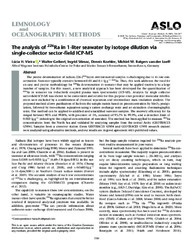The analysis of 226Ra in 1‐liter seawater by isotope dilution via single‐collector sector‐field ICP‐MS
Vieira, Lúcia H.; Geibert, Walter; Stimac, Ingrid; Koehler, Dennis; Rutgers van der Loeff, Michiel M., 2021: The analysis of 226Ra in 1‐liter seawater by isotope dilution via single‐collector sector‐field ICP‐MS. In: Limnology and Oceanography: Methods, Band 19, 5: 356 - 367, DOI: 10.23689/fidgeo-4415.
 |
Dokument öffnen: |
The precise determination of radium‐226 (226Ra) in environmental samples is challenging due to its low concentration. Seawater typically contains between 0.03 and 0.1 fg g−1 226Ra. Thus, this work addresses the need for an easy and precise methodology for 226Ra determination in seawater that may be applied routinely to a large number of samples. For this reason, a new analytical approach has been developed for the quantification of 226Ra in seawater via inductively coupled plasma mass spectrometry (ICP‐MS). Analysis by single collector sector‐field ICP‐MS was shown to be convenient and reliable for this purpose once potential molecular interferences were excluded by a combination of chemical separation and intermediate mass resolution analysis. The proposed method allows purification of Ra from the sample matrix based on preconcentration by MnO2 precipitation, followed by two‐column separation using a cation exchange resin and an extraction chromatographic resin. The method can be applied to acidified and unacidified seawater samples. The recovery efficiency for Ra ranged between 90% and 99.8%, with precision of 5%, accuracy of 95.7% to 99.9%, and a detection limit of 0.033 fg g−1 (referring to the original concentration of seawater). The method has been applied to measure 226Ra concentrations from the North Sea and validated by analyzing samples from the central Arctic (GEOTRACES GN04). Samples from a crossover station (from GEOTRACES GN04 and GEOTRACES GN01 research cruises) were analyzed using alternative methods, and our results are in good agreement with published values.
Statistik:
ZugriffsstatistikSammlung:
This is an open access article under the terms of the Creative Commons Attribution License, which permits use, distribution and reproduction in any medium, provided the original work is properly cited.

